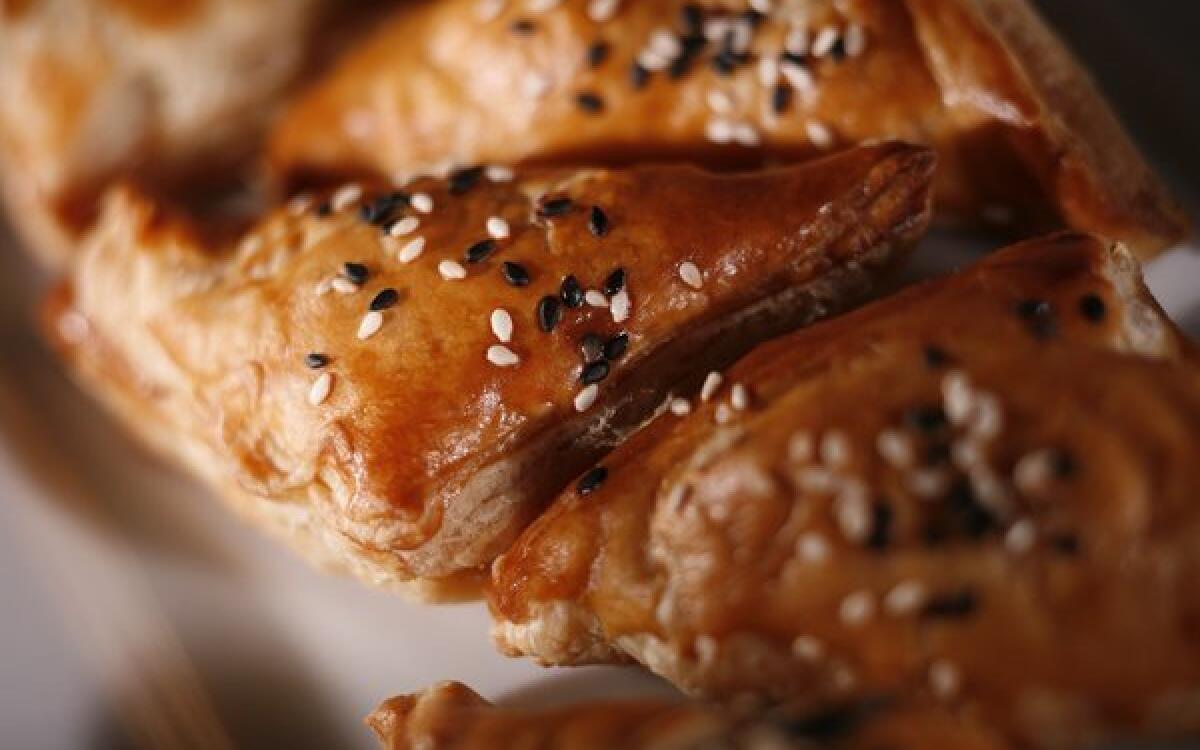Chickpea turnovers

As a child in Hebrew school, I was taught the story of the Hanukkah miracle: When the Jews in the land of Israel defeated the foreigners, the priests seeking to rekindle the templeâs eternal light found enough ritually pure oil for only one day. Miraculously that oil lasted for eight days.
Since then, Jews have been celebrating Hanukkah every year by lighting candles every day for eight days. Children in Israel play with dreidels inscribed with the first Hebrew letters of the phrase âa big miracle happened hereâ; in Washington, D.C., my birthplace, our dreidels had the first letters of âa big miracle happened there.â
Until I lived in Israel, I associated the holiday with latkes, or potato pancakes. But when I moved there I discovered that for many Israelis, sufganiyot, or jelly doughnuts, are the favorite Hanukkah treat. I also realized that the connection of such foods to Hanukkah is the oil in which they are fried.
What we hadnât learned in Hebrew school was that the oil of the Hanukkah miracle was olive oil. In ancient Israel, olive oil was used for lighting lamps, for religious rituals and for cooking. Based on archaeological evidence, the land of Israel was an olive oil production center.
Olive oil is rarely used to fry latkes or sufganiyot, specialties that came to us from Central and Eastern Europe, where olive oil is not part of the culinary culture. Yet it seems natural to use the oil of the miracle in Hanukkah menus, along with other foods from biblical Israel. Wheat and barley were staples, and so were vegetables and a variety of fresh and dried fruits, including pomegranates, raisins and olives, which make a colorful topping for the greens of our Hanukkah salad.
Legumes were important in the daily meals of the people of the Holy Land. To make our holiday appetizer, I mix chickpeas, which are native to the Fertile Crescent, with onions sauteed in olive oil, and use the mixture as a filling for turnovers. Such turnovers and other old-fashioned treats were often fried because people didnât have ovens at home. These days baked treats are more convenient to prepare, keep better when made in advance and are easier to reheat.
In ancient Israel, bread was the center of the meal. For Hanukkah, I bake a holiday kubanah, a slightly sweet bread based on my Yemenite mother-in-lawâs overnight Shabbat bread, which I flavor with a touch of fig jam or preserves. To enrich the bread, I spread pieces of the dough with olive oil and softened butter. I roll each piece in a spiral and, as they slowly bake, the pieces come together as a cake.
Hanukkah has become a holiday for potato lovers, even though this New World tuber is a relative newcomer to the lands of the Bible. As an alternative to the common pancakes, I prepare a potato kugel topped with sour cream and cheese, the quintessential foods of the âland of milk and honey.â
In a large, heavy skillet, heat the oil over medium heat. Add the onion and cook, stirring occasionally, until it is tender and light golden, about 10 minutes. Add the jalapeno pepper, if using, the garlic and the cumin, and cook over low heat, stirring, for 2 minutes. Remove from heat.
Chop the chickpeas in a food processor with a pulsing motion, leaving a few small pieces. Transfer the chickpeas to a medium bowl. Add the onion mixture and mix well. Season to taste with salt, pepper and cayenne.
Unfold one pastry sheet on a cool, lightly floured surface (keep the other sheet refrigerated). Roll the pastry sheet out to a 12-by-9-inch rectangle. Cut the sheet into 12 (3-inch) squares.
Spoon 2 teaspoons of the filling in the center of each square. Brush the edges of the dough around the filling with the beaten egg. Fold the pastry over the filling to form triangles. Pinch the edges together firmly.
Sprinkle 2 foil-lined baking sheets with water. Place the filled pastries onto one of the sheets. Brush the center of each pastry with beaten egg, and sprinkle over the sesame seeds. Refrigerate the sheet for at least 30 minutes before baking. Meanwhile, roll out the second puff pastry sheet and form the rest of the pastries. This makes about one-half cup more filling than is needed for the pastries; the remaining filling can be used as a spread for toast or crackers.
Heat the oven to 400 degrees. Bake the pastries for 10 minutes, then rotate each baking sheet and continue baking until the pastries are puffed and browned, about 6 minutes more. Serve hot or warm.
Get our Cooking newsletter.
Your roundup of inspiring recipes and kitchen tricks.
You may occasionally receive promotional content from the Los Angeles Times.















